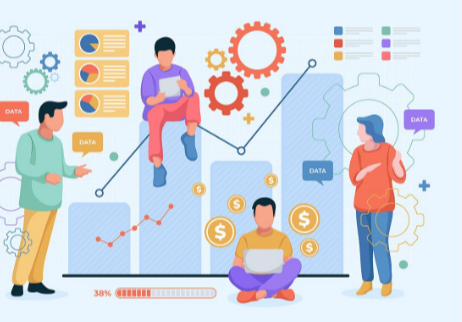How a Software Development Agency Fuels Digital Growth

Custom software is no longer a luxury; it is a necessity. For executives, SME owners, product leaders, and investors, it has become the backbone of modern growth strategies. Unlike generic platforms, custom-built solutions adapt to unique business goals, scale with demand, and keep customers engaged in ways off-the-shelf tools cannot.
A software development agency brings this vision to life by aligning technology with strategy, building systems that not only address immediate challenges but also lay a foundation for long-term success. Beyond just coding, agencies bring a combination of technical expertise, industry insights, and innovation to help businesses remain competitive in rapidly evolving markets.
To fully appreciate the value that agencies bring today, it is useful first to examine how their role in driving business growth has evolved, shifting from simple service providers to strategic partners in digital transformation.
The Evolving Role of Software Development in Business Growth
Software is no longer just a support function; it has become a strategic asset. It has become the core driver of business value. In 2024 and 2025, businesses that thrive are the ones that integrate technology into every decision. Growth depends on digital systems that enhance efficiency, create valuable insights, and improve customer experiences. Agencies play a critical role by helping companies shift from simply going digital to becoming digitally competitive.
Beyond Coding – Agencies as Strategic Partners
- Agencies today are far more than coding teams. They act as collaborators who shape the bigger picture, influencing not only how products are built but also how businesses grow. By stepping into the role of strategic partner, a software development agency ensures that every line of code contributes to broader business objectives.
- Roadmap Creation: Instead of focusing only on immediate deliverables, agencies help define long-term technology roadmaps. This involves forecasting how systems should evolve to support expansion, adapt to market shifts, and remain cost-efficient over the years.
- Growth Alignment: Successful agencies don’t just deliver features; they connect digital products directly to measurable KPIs such as revenue growth, reduced churn, improved retention, and customer lifetime value. This ensures technology investments are always tied to tangible business outcomes.
- Innovation Enablement: Beyond execution, agencies often act as catalysts for innovation. They bring fresh perspectives, experiment with emerging technologies, and help businesses identify opportunities in new markets or customer segments that may not have been obvious internally.
With a strategy in place, agencies also ensure businesses stay ahead by adopting technologies that prepare them for the future.
Driving Growth Through Future-Ready Technologies
Growth today is technology-driven. Companies must adopt tools that are adaptable, scalable, and future-ready. Agencies guide this adoption, ensuring businesses select technologies that can stand the test of time while also keeping them competitive in fast-changing markets.
- AI-driven Automation: Enhances personalization and eliminates inefficiency.
- Cloud-native Development: Provides flexibility, resilience, and reduced operational costs.
- Edge and IoT Integration: Powers real-time, localized decisions for smarter outcomes.
AI-First Development Approaches
AI is no longer optional. It is now an integral part of modern solutions.
- Predictive Analytics: Anticipates customer behaviour to personalize engagement.
- Intelligent Automation: Frees employees from repetitive tasks.
- AI Code Accelerators: Reduce Time-to-Market While Ensuring Reliability.
Of course, advanced technologies are of little value without the ability to deliver products quickly. That’s where Agile and DevOps come in.
Accelerating Time-to-Market with Agile and DevOps
In today’s environment, speed equals growth. Companies that launch faster maintain a stronger market position. Agencies integrate Agile and DevOps practices to strike a balance between quality and speed, enabling businesses to test, iterate, and scale efficiently.
- Continuous Delivery: Keeps products relevant through frequent updates.
- Hybrid Agile Models: Ensure Distributed Global Teams Deliver Seamlessly.
- Rapid Iteration: Shortens development cycles with constant feedback.
DevOps as a Business Growth Lever
DevOps now goes beyond engineering efficiency. It creates a direct business impact.
- Automated Infrastructure: Enables cost-efficient scaling.
- Secure Deployment Pipelines: Support rapid delivery without risk.
- Cross-Functional Synergy: Aligns product, design, and engineering for faster releases.
Once products are delivered quickly, the next challenge is making them engaging and seamless for customers.
Building Seamless Digital Experiences for Customers
Customer experience defines loyalty. Businesses win when they create products that are intuitive, fast, and consistent. Agencies specialize in designing experiences that improve engagement, build trust, and extend lifetime value.
- User-Centric Design: Simplifies complex interactions.
- Progressive Web Apps (PWAs): Deliver speed and accessibility across devices.
- Microservices: Scale personalization features without compromising performance.
Omnichannel Experience Engineering
Customers expect consistency across all touchpoints. Agencies ensure every interaction is connected.
- Unified Journeys: Create seamless experiences across mobile, web, and IoT.
- API Ecosystems: Build integrations that power business efficiency.
- Real-Time Data: Instantly adapt user journeys to improve retention.
Delivering excellent customer experiences today also requires a commitment to innovation, which is why many agencies are building dedicated innovation labs.
Read Also: Geekzilla.tech Honor Magic 5 Pro: A Comprehensive Review
Innovation Labs within Agencies as Growth Catalysts
Innovation drives growth in competitive industries. Many agencies now build internal labs to explore emerging technologies and create prototypes. This experimentation gives businesses access to bold new solutions without the risk of heavy upfront investment.
- Web3 and AR/VR: Test immersive and decentralized experiences.
- Generative AI: Develop adaptive, evolving digital solutions.
- Prototyping: Validate product concepts quickly and cost-effectively.
Co-Creation with Clients
Collaboration amplifies innovation. Agencies bring clients into the process from the start.
- Collaborative Sprints: Encourage rapid ideation with shared accountability and responsibility.
- Proof-of-Concepts: Validate solutions before scaling to full rollouts.
- Shared Outcomes: Drive stronger partnerships through mutual success.
As businesses innovate, they must also protect their digital assets. Security and resilience become the foundation for sustainable growth.
Ensuring Digital Resilience and Cybersecurity
Security is the foundation of sustainable growth. Without it, businesses risk losing both trust and revenue. Agencies integrate resilience into every product they build, ensuring solutions are secure and compliant by design.
- Secure-by-Design: Embedding protection from the start.
- Privacy by Design: Safeguarding sensitive data as a default.
- Zero-Trust Architectures: Creating safer digital environments for 2025 and beyond.
Security as a Growth Enabler
Security is not just about reducing risks. It creates confidence in customers and investors.
- Strong Protection: Prevents breaches that damage reputation.
- Automated Testing: Ensures vulnerabilities are identified and addressed early.
- Future-Proofing: Adapts products to evolving threats.
To determine if an agency is truly delivering value, businesses need clear methods to measure its impact.
Read Also: Kongotech.org: What You Need to Know About This Tech Organization
Measuring the Impact of an Agency on Digital Growth
The value of an agency is seen not just in its delivery, but also in its ability to create long-term growth. Businesses measure impact through adaptability, efficiency, and outcomes.
- Scalability: Does the solution support business expansion?
- ROI Beyond Costs: Do investments drive efficiency, engagement, and market share?
- Customer Lifetime Value: Are Retention and Loyalty Increasing?
From Vendor to Trusted Growth Partner
Agencies that deliver consistent results become more than vendors. They evolve into strategic partners.
- Long-Term Value Creation: Building products that scale with the business.
- Resilience Building: Ensuring Businesses Adapt to Disruption.
- Strategic Relationships: Acting as an extension of the leadership team.
With all these elements combined, the conclusion is clear. The right agency is not just a builder but a true growth catalyst.
Conclusion
Digital growth today is not just about adopting the latest tools—it is about building secure, adaptable, and scalable solutions that can evolve with the business. A software development agency fuels this growth by combining strategy, technology, and innovation to deliver outcomes that go beyond code.
The right agency is more than a vendor. It becomes a trusted partner that helps businesses accelerate time-to-market, unlock innovation, enhance customer experiences, and ensure resilience in an ever-changing digital landscape.
For organizations aiming to lead, the path forward is clear: growth will be driven by strategic collaboration with agencies that design, build, and scale technology as an actual engine of business success.




